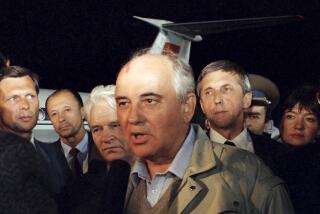The Soviet Presidency
- Share via
THE JOB: The office of president was established for the first time by the Third Congress of People’s Deputies in March, 1990. The president, under the Soviet constitution, Article 127, is the “head of the Soviet state.” The president is elected by universal, direct and secret ballot.
ELIGIBILITY: Any Soviet citizen between the ages of 35 and 65 may be elected to the post for a maximum of two five-year terms.
DUTIES: The president represents the Soviet Union nationally and internationally, nominates the prime minister and members of the Cabinet of Ministers, chairs the Security Council of the Soviet Union and heads a Council of the Federation, which is responsible for the coordination of state institutions and nationality matters.
GORBACHEV: Mikhail S. Gorbachev was elected president March 16, 1990 (exceptionally, by the Congress of People’s Deputies, rather than by a nationwide ballot). Vice President Gennady I. Yanayev assumed the duties of president today under Article 127, Clause 7 of the constitution because Gorbachev could no longer perform his duties for health reasons, the official Tass news agency said.
Source: The Statesman’s Year-Book 1991-92, Times Wire Services
More to Read
Sign up for Essential California
The most important California stories and recommendations in your inbox every morning.
You may occasionally receive promotional content from the Los Angeles Times.












